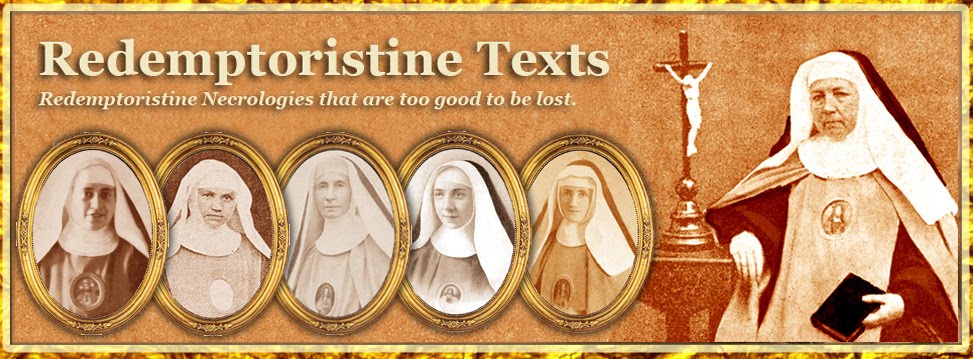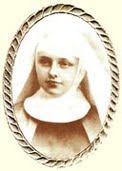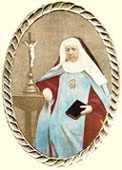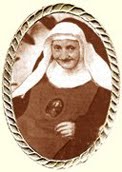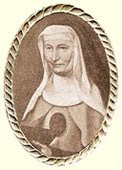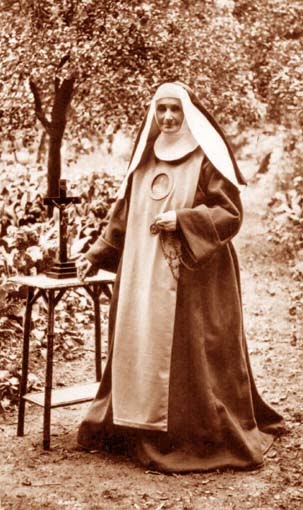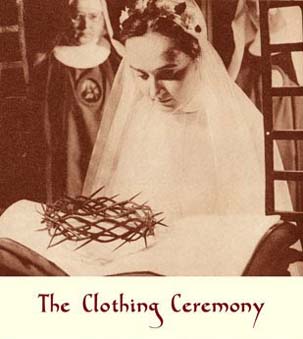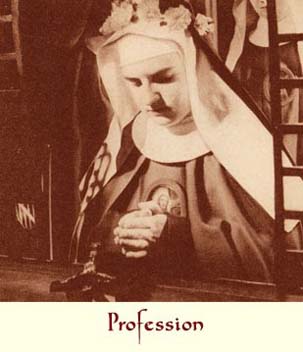Foundation of the Monastery of Dublin
CHAPTER III.
The Last Trials – The Last Years
CHAPTER III.
The Last Trials – The Last Years
The spiritual edifice and the material edifice were therefore raised up, and God's eyes dwelt upon them with pleasure. But the Lord has said: “Your ways are not My ways, your thoughts are not My thoughts.” To perfect the courageous soul that had brought so great a work to such a good end, God sent her the cross. “For great souls”, it has been justly said, “Tabor is Calvary”. Mother Mary-Jean of the Cross had her Calvary: her resignation to the will of God and her lively faith made a Tabor of it.
It is indeed a very mysterious thing, this suffering given as a reward for good actions and we cannot assign a better reason for it than the will of God. God wants all His elect to resemble the divine model, Jesus crucified in some way; for His elect of predilection, He wants this resemblance to be more striking. Named Assistant after having been Superior for long years, Mother Mary-Jean showed herself as submissive a daughter as she had been devoted as a Mother; but this change was of small account beside her interior pains and desolations. An illuminated director then wrote to this Mother in terms that we wish to quote: “Jesus is calling you to follow Him in the way strewn with thorns that He walked while on earth when His life was a continual cross. Have confidence: the Master will sustain you. Oh! how consoling it is to think that every test is a mark of love on the part of God, that He has weighed it before imposing the burden of it upon us, and that graces, strength and help are always granted to us in the measure of the sacrifice! Nature may tremble, and you may perhaps say like Jesus in the Garden of the Olives: Father, may this chalice pass far from me! but love must very quickly make you add with your Heart submitted to Our Lord: Not my will, my God, but yours! –Then, when tribulation has purified your soul, it will be free and happy and sing the hymn of its deliverance. May these thoughts of faith sustain you!”
Never were opinions given more opportunely. They were received with gratitude and observed submissively. And then, when some unexpected circumstances determined Mother Mary-Jean of the Cross to leave Ireland, she left (1894) with the same submissiveness to the will of God that she had had in 1845, at the time of her entry into the Order. In fact, a precious friendship asked her to found a new monastery of Redemptoristines in France: the good Mother believed she had to accept. So we can understand with what sadness of heart she departed from the dear monastery of Dublin to which she had given the best part of her life; but if the sacrifice was great, the devotion to God's glory was greater still. Mother Mary-Jean was going to live for a while in the Redemptoristine Convent of Saint-Amand-Les-Eaux, where Mother Marie-Joseph of the Child Jesus was the Superior. It was this worthy nun who had formed the project of which we have spoken, and her great heart thus wished to propagate her Order in this same France that one day was to exile her. Mother Mary-Jean of the Cross responded to her desire, and put all her activity into procuring the realization of it. But God did not permit the success of this attempt. The event proved clearly that Providence itself conducts all affairs. The new foundation was to be only a new prey prepared for the greed of the revolutionary treasury, and it was to sink into the abyss with so many others in the wonderful times that we had to live through. The good Superior of Saint-Amand had the sorrow of seeing her own convent sold at public auction, and be obliged to go into exile with her daughters as a stranger on earth; but God, by a just return, granted her to die on the hospitable soil of Belgium where she had, long years before, begun her religious life; and her supreme consolation was to have assured the future of her daughters. As for Mother Mary-Jean of the Cross, she retired in 1895 to this dear monastery of Velp, whose furnishing she had prepared so well in 1858; and there, in company of beloved Sisters who surrounded her with their affection and respect, with a good Irish converse Sister beside her, who had come into exile with her, she spent her last years in peace and holiness.
Before her death, God reserved her a touching consolation. Called to Tournai in 1893 by the ecclesiastical tribunal collecting information regarding the life and reputation for holiness of the Most Rev. Fr. Joseph Passerat (today Venerable), she made as deep an impression on the judges by the superiority of her spirit, her character and her virtues, as by the importance of her deposition. It was the Ven. Fr. Passerat, it may be remembered, who in 1845 had opened the doors of the Monastery of Bruges to her. It was probably very pleasant for the Reverend Mother to tell everything she knew about the life and virtues of this Servant of God, and she also testified that she herself had felt the effect of his intercession with God. One day she was nearly choked by a big piece of fishbone, so she rubbed her throat with a picture of Fr. Passerat and the bone immediately detached itself, and she was able to remove it.
June 15, 1902 saw the end of the beautiful life whose sketch we have just drawn. For seven years, by her fervour, this good Mother had edified the dear monastery that had offered her such cordial hospitality. Her death was sweet and peaceful. After receiving the last sacraments, for one last time she remembered that dear convent of Dublin that she had loved so much. Her eyes thanked the good Superior of Velp, the Sisters that surrounded her and good Sister Aloysia her inseparable companion and then she returned her beautiful soul to God. She was 77 years of age. Her funeral ceremony was both touching and splendid. Several members of the family of the venerable deceased made it their duty to accompany her mortal remains right to her tomb, and it was in the midst of the general emotion that the body of Mother Mary-Jean of the Cross was confided to the earth.
The Redemptoristine convents, notably those of Dublin and Clapham (London) mixed their regrets with their tributes. The Monastery of Dublin wished to dedicate a very special memorial to their pious foundress. They erected a monument to her in the Sisters’ cemetery, and a beautiful inscription, engraved on white marble, recalls her good work there forever.
Let us not finish these pages without saying some words about the high esteem that some very distinguished personages had for Mother Mary-Jean of the Cross. His Eminence Cardinal Cullen looked upon her as a person who was both pious and intelligent, and ensured that the Holy See confirmed her for many years in her position as Superior. – Cardinal MacCabe, his successor in the seat of Dublin, had the same esteem for her and professed the same admiration for her good character. The Venerable successor of these two Prelates paid an outstanding tribute to this good Mother when he said of her: “Look at her soul. No matter what side you turn it, you will always see it as clear a diamond.”
The Most Rev. Fr. Mauron, the Superior General of the Community of the Most Holy Redeemer, helped Mother Mary-Jean of the Cross with his advice. You could fill a great volume with his correspondence with this servant of God. –The Rev. Fr. Coffin, the Redemptorist who died as the Bishop of Southwark, Rev. Fr. Bridgett and Rev. Fr. Harbison all shared the same sentiments. And finally there were also men of the world who paid homage to her perfect understanding of even temporal matters. The notary Rouch said one day: “Madame the Superior is the equal of everyone by her intelligence, knowledge and prudence and it is with a consummate wisdom that she manages the temporal affairs of her community.”
The Most Rev. Fr. Raus, the Redemptorist Superior General, had the opportunity, in 1904, of visiting the monastery and church of the Sisters of Dublin. After examining everything in detail, he did not hesitate to say these beautiful words: “I already had the highest esteem for Mother Mary-Jean of the Cross; now I esteem her even more."
It is indeed a very mysterious thing, this suffering given as a reward for good actions and we cannot assign a better reason for it than the will of God. God wants all His elect to resemble the divine model, Jesus crucified in some way; for His elect of predilection, He wants this resemblance to be more striking. Named Assistant after having been Superior for long years, Mother Mary-Jean showed herself as submissive a daughter as she had been devoted as a Mother; but this change was of small account beside her interior pains and desolations. An illuminated director then wrote to this Mother in terms that we wish to quote: “Jesus is calling you to follow Him in the way strewn with thorns that He walked while on earth when His life was a continual cross. Have confidence: the Master will sustain you. Oh! how consoling it is to think that every test is a mark of love on the part of God, that He has weighed it before imposing the burden of it upon us, and that graces, strength and help are always granted to us in the measure of the sacrifice! Nature may tremble, and you may perhaps say like Jesus in the Garden of the Olives: Father, may this chalice pass far from me! but love must very quickly make you add with your Heart submitted to Our Lord: Not my will, my God, but yours! –Then, when tribulation has purified your soul, it will be free and happy and sing the hymn of its deliverance. May these thoughts of faith sustain you!”
Never were opinions given more opportunely. They were received with gratitude and observed submissively. And then, when some unexpected circumstances determined Mother Mary-Jean of the Cross to leave Ireland, she left (1894) with the same submissiveness to the will of God that she had had in 1845, at the time of her entry into the Order. In fact, a precious friendship asked her to found a new monastery of Redemptoristines in France: the good Mother believed she had to accept. So we can understand with what sadness of heart she departed from the dear monastery of Dublin to which she had given the best part of her life; but if the sacrifice was great, the devotion to God's glory was greater still. Mother Mary-Jean was going to live for a while in the Redemptoristine Convent of Saint-Amand-Les-Eaux, where Mother Marie-Joseph of the Child Jesus was the Superior. It was this worthy nun who had formed the project of which we have spoken, and her great heart thus wished to propagate her Order in this same France that one day was to exile her. Mother Mary-Jean of the Cross responded to her desire, and put all her activity into procuring the realization of it. But God did not permit the success of this attempt. The event proved clearly that Providence itself conducts all affairs. The new foundation was to be only a new prey prepared for the greed of the revolutionary treasury, and it was to sink into the abyss with so many others in the wonderful times that we had to live through. The good Superior of Saint-Amand had the sorrow of seeing her own convent sold at public auction, and be obliged to go into exile with her daughters as a stranger on earth; but God, by a just return, granted her to die on the hospitable soil of Belgium where she had, long years before, begun her religious life; and her supreme consolation was to have assured the future of her daughters. As for Mother Mary-Jean of the Cross, she retired in 1895 to this dear monastery of Velp, whose furnishing she had prepared so well in 1858; and there, in company of beloved Sisters who surrounded her with their affection and respect, with a good Irish converse Sister beside her, who had come into exile with her, she spent her last years in peace and holiness.
Before her death, God reserved her a touching consolation. Called to Tournai in 1893 by the ecclesiastical tribunal collecting information regarding the life and reputation for holiness of the Most Rev. Fr. Joseph Passerat (today Venerable), she made as deep an impression on the judges by the superiority of her spirit, her character and her virtues, as by the importance of her deposition. It was the Ven. Fr. Passerat, it may be remembered, who in 1845 had opened the doors of the Monastery of Bruges to her. It was probably very pleasant for the Reverend Mother to tell everything she knew about the life and virtues of this Servant of God, and she also testified that she herself had felt the effect of his intercession with God. One day she was nearly choked by a big piece of fishbone, so she rubbed her throat with a picture of Fr. Passerat and the bone immediately detached itself, and she was able to remove it.
June 15, 1902 saw the end of the beautiful life whose sketch we have just drawn. For seven years, by her fervour, this good Mother had edified the dear monastery that had offered her such cordial hospitality. Her death was sweet and peaceful. After receiving the last sacraments, for one last time she remembered that dear convent of Dublin that she had loved so much. Her eyes thanked the good Superior of Velp, the Sisters that surrounded her and good Sister Aloysia her inseparable companion and then she returned her beautiful soul to God. She was 77 years of age. Her funeral ceremony was both touching and splendid. Several members of the family of the venerable deceased made it their duty to accompany her mortal remains right to her tomb, and it was in the midst of the general emotion that the body of Mother Mary-Jean of the Cross was confided to the earth.
The Redemptoristine convents, notably those of Dublin and Clapham (London) mixed their regrets with their tributes. The Monastery of Dublin wished to dedicate a very special memorial to their pious foundress. They erected a monument to her in the Sisters’ cemetery, and a beautiful inscription, engraved on white marble, recalls her good work there forever.
Let us not finish these pages without saying some words about the high esteem that some very distinguished personages had for Mother Mary-Jean of the Cross. His Eminence Cardinal Cullen looked upon her as a person who was both pious and intelligent, and ensured that the Holy See confirmed her for many years in her position as Superior. – Cardinal MacCabe, his successor in the seat of Dublin, had the same esteem for her and professed the same admiration for her good character. The Venerable successor of these two Prelates paid an outstanding tribute to this good Mother when he said of her: “Look at her soul. No matter what side you turn it, you will always see it as clear a diamond.”
The Most Rev. Fr. Mauron, the Superior General of the Community of the Most Holy Redeemer, helped Mother Mary-Jean of the Cross with his advice. You could fill a great volume with his correspondence with this servant of God. –The Rev. Fr. Coffin, the Redemptorist who died as the Bishop of Southwark, Rev. Fr. Bridgett and Rev. Fr. Harbison all shared the same sentiments. And finally there were also men of the world who paid homage to her perfect understanding of even temporal matters. The notary Rouch said one day: “Madame the Superior is the equal of everyone by her intelligence, knowledge and prudence and it is with a consummate wisdom that she manages the temporal affairs of her community.”
The Most Rev. Fr. Raus, the Redemptorist Superior General, had the opportunity, in 1904, of visiting the monastery and church of the Sisters of Dublin. After examining everything in detail, he did not hesitate to say these beautiful words: “I already had the highest esteem for Mother Mary-Jean of the Cross; now I esteem her even more."
This necrology is translated from Fleurs de l'Institut des Rédemptoristines by Mr John R. Bradbury. The copyright of this translation is the property of the Redemptoristine Nuns of Maitland, Australia. The integral version of the translated book will be posted here as the necrologies appear.
